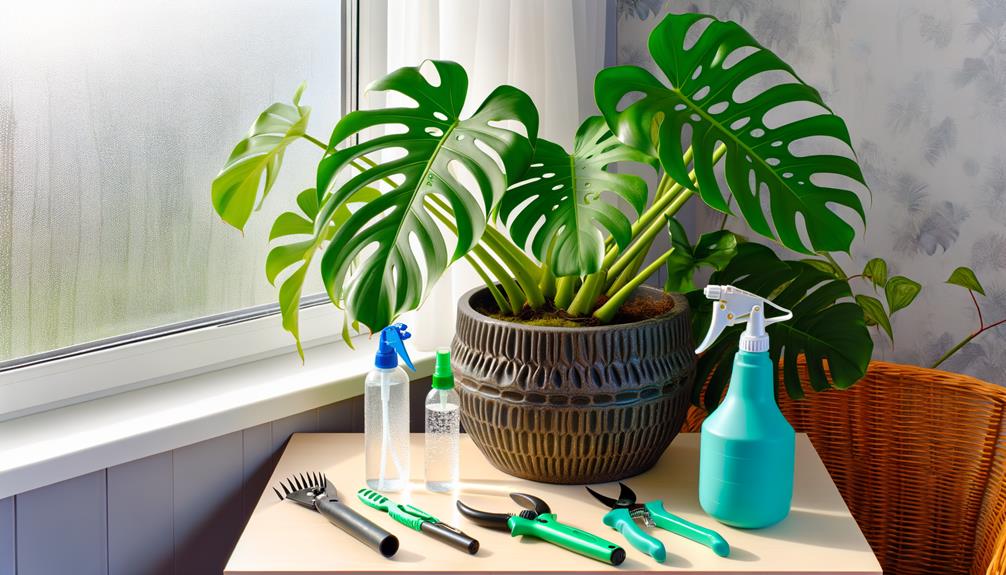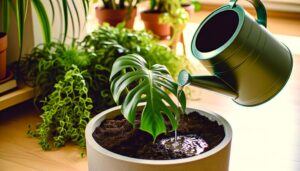How Do I Care for an XXL Monstera Plant?
To care for your XXL Monstera deliciosa, water when the top two inches of soil are dry using filtered, room temperature water. Position it in bright, indirect light near east or north-facing windows.
Use a well-draining soil mix with peat, bark, and perlite, and make certain the pot has drainage holes. Maintain humidity around 60-80% with a humidifier or misting.
Prune dead or crowded leaves with sterilized shears and provide stakes for vertical support. Fertilize with a balanced, water-soluble fertilizer every 4-6 weeks during the growing season.
Regularly check for pests like spider mites and treat as necessary. To learn additional techniques, continue exploring.

Key Takeaways
- Water when the top two inches of soil are dry, using filtered room temperature water.
- Provide bright, indirect light and rotate the plant for uniform exposure.
- Use a well-draining soil mix and repot every 1-2 years with a slightly larger container.
- Maintain 60-80% humidity using a humidifier or misting leaves regularly.
- Inspect for pests regularly and treat infestations with mild soap or horticultural oils.
Watering Needs
To guarantee your XXL Monstera deliciosa prospers, water it thoroughly when the top two inches of soil are dry. Insert your finger into the soil to measure this accurately. Use filtered water at room temperature to avoid shocking the roots. Slowly pour water until it drains from the pot's bottom, ensuring even distribution. Don't let the plant sit in water; empty the saucer after watering.
During the growing season (spring and summer), you'll need to water more frequently as the plant's metabolic processes accelerate. In contrast, reduce watering in the dormant period (fall and winter) since the plant's water uptake decreases. Regularly check soil moisture to prevent root rot (Rhizoctonia solani) and maintain ideal hydration for your Monstera deliciosa.
Light Requirements
Your Monstera deliciosa requires bright, indirect light to thrive, mimicking its natural understory habitat. Position it near east or north-facing windows, ensuring it's shielded from direct sunlight, which can cause leaf burn.
Utilize sheer curtains or place the plant a few feet away from the light source to achieve the best lighting conditions.
Ideal Light Conditions
Promoting ideal growth for an XXL Monstera (Monstera deliciosa) involves providing bright, indirect light to mimic its natural rainforest habitat. Aim to place your plant near an east or north-facing window, where it can receive filtered sunlight.
For best light conditions, follow these steps:
- Use translucent curtains to diffuse direct sunlight, preventing leaf burn.
- Rotate the plant every few weeks to ensure uniform light exposure on all sides.
- Supplement with artificial grow lights if natural light is insufficient, making sure they emit a full spectrum of light.
- Monitor light intensity using a light meter, aiming for 10,000 to 20,000 lux.
Avoid Direct Sunlight
Direct sunlight can scorch the leaves of Monstera deliciosa, leading to unsightly brown spots and impaired growth. Position your Monstera in a spot where it receives bright, indirect light for best health. East-facing windows are ideal, providing morning sun without the intensity that can damage the foliage. Alternatively, a few feet away from a south or west-facing window works well. Use sheer curtains to diffuse the light if necessary.
Monitor the plant regularly for any signs of leaf discoloration. If you notice browning, it may indicate too much direct light. Adjust its placement accordingly.
Soil and Potting
Selecting the appropriate soil mix for your XXL Monstera deliciosa is crucial, as it necessitates a well-draining medium enriched in organic matter. Utilize a container with drainage holes to avoid waterlogging, which can result in root rot.
A suggested soil blend comprises:
- Peat moss – Retains moisture without saturating.
- Perlite – Improves aeration and prevents soil compaction.
- Pine bark – Introduces organic material and aids in drainage.
- Coconut coir – Enhances moisture retention and enhances soil composition.
Replant your Monstera every 1-2 years to renew the soil and accommodate growth. During replanting, gently loosen the root ball to stimulate new root growth. Verify that the new container is slightly larger to provide ample room for root expansion, fostering overall plant wellness.
Humidity Levels
Maintaining ideal humidity levels is essential for your XXL Monstera deliciosa. Aim for a relative humidity range of 60-80%, using a hygrometer to monitor levels consistently.
If necessary, increase humidity with a humidifier or by grouping plants together.
Ideal Humidity Range
To make sure your XXL Monstera plant thrives, you should maintain an ambient moisture level between 60% and 80%, as Monstera deliciosa requires consistent moisture for optimal growth and health. Monitoring and adjusting moisture levels is essential, especially in arid climates or during winter when indoor air tends to be drier.
Here's how to guarantee your Monstera gets the necessary humidity:
- Use a hygrometer: Regularly check moisture levels to confirm they stay within the ideal range.
- Group plants together: This can naturally increase moisture through transpiration.
- Place a humidity tray: Fill a tray with water and pebbles beneath the plant to create localized moisture.
- Mist your plant: Lightly mist the leaves with water, avoiding over-saturation which can lead to fungal issues.
Increasing Humidity Levels
To effectively increase humidity levels for your XXL Monstera deliciosa, employ strategies such as using a humidifier or creating a microenvironment with a humidity dome. A humidifier can maintain consistent moisture levels, while a humidity dome traps evaporated water. For best results, place the Monstera in a room with other plants to create a natural humidity boost through transpiration. Additionally, misting the leaves can provide temporary relief.
| Strategy | Description | Benefits |
|---|---|---|
| Humidifier | Device that releases water vapor | Consistent humidity levels |
| Humidity Dome | Clear cover trapping moisture | Microenvironment creation |
| Grouping Plants | Placing plants together | Natural transpiration boost |
| Leaf Misting | Spraying water on leaves | Temporary humidity increase |
Implement these methods to optimize your Monstera thrives in a humid environment.
Monitoring Humidity Consistently
Consistently monitoring humidity levels is crucial for the health of your Monstera deliciosa, requiring precision instruments like hygrometers to guarantee the environment stays within the ideal 60-80% humidity range.
Here's how you can ensure prime conditions:
- Place Hygrometers Strategically: Position hygrometers close to the plant to monitor the microenvironment accurately.
- Regularly Check Readings: Make it a daily routine to check humidity levels and record them, ensuring uniformity.
- Adjust as Needed: Use humidifiers or misting if levels drop below 60%. Dehumidifiers can help if humidity exceeds 80%.
- Maintain Airflow: Ensure proper ventilation to prevent stagnant air, which can cause fungal issues.
Pruning Techniques
Effective pruning techniques for your Monstera deliciosa involve strategically removing dead or diseased leaves to promote healthier growth and maintain the plant's structural integrity. Use sterilized pruning shears to make clean cuts at the base of each affected leaf petiole.
Examine the plant for crowded areas where leaves may be competing for light and remove select leaves to improve airflow. Trim aerial roots sparingly, as they assist in nutrient absorption and structural support. Always cut just above a node to encourage new growth.
Avoid removing more than 25% of the foliage at one time to prevent shock. Regularly inspect your plant, focusing on the undersides of leaves for pests or signs of disease. This promotes overall plant importance and longevity.
Support Structures
After mastering pruning techniques, it's equally important to establish robust support structures for your Monstera deliciosa to accommodate its vigorous growth and sprawling nature. Utilize materials like moss poles or trellises to guide the aerial roots and climbing stems.
Follow these steps to achieve optimal support:
- Select a sturdy support: Choose a moss pole or trellis that can bear the weight of your mature Monstera.
- Anchor securely: Firmly insert the support into the potting mix to prevent tipping.
- Attach stems: Gently tie the stems to the support using soft plant ties to avoid damage.
- Monitor growth: Regularly adjust ties and supports as the plant grows, ensuring even distribution.
Proper support structures prevent root damage and promote healthy, vertical growth.
Fertilizing Tips
To guarantee your Monstera deliciosa thrives, apply a balanced, water-soluble fertilizer every 4-6 weeks during the growing season. Choose a fertilizer with a proportionate N-P-K (nitrogen, phosphorus, potassium) ratio, such as 20-20-20. Dilute the fertilizer to half the recommended strength to avoid over-fertilization, which can lead to root burn and nutrient imbalances.
Ensure the soil is moist before fertilizing to enhance nutrient absorption. During the dormant period, typically in winter, reduce fertilization frequency to every 8-10 weeks, or suspend it entirely. Monitor your plant's response, as yellowing leaves may indicate nutrient deficiency, necessitating adjustments.
Consistent fertilization supports vigorous growth and lush foliage, essential for an XXL Monstera's health and aesthetic appeal.
Pest Management
Maintaining a vigorous fertilization routine helps strengthen your Monstera deliciosa, but you'll also need to be vigilant about common pests like spider mites (Tetranychus urticae) and scale insects (Coccoidea). Regularly inspect both sides of the leaves and the stems for signs of infestation.
To manage pests effectively:
- Isolate: Quarantine the affected plant to prevent spreading to others.
- Cleanse: Wash leaves with a solution of mild soap and water.
- Apply: Use horticultural oils or insecticidal soaps to treat infestations.
- Monitor: Continuously check for re-emergence and treat as necessary.
Repotting Guide
Repotting your Monstera deliciosa involves selecting a container that's 2-3 inches larger in diameter than the current one to accommodate its growing root system. Ensure the new pot has adequate drainage holes to prevent waterlogging. Fill the bottom with a layer of gravel or broken pottery to enhance drainage. Use a well-draining soil mix, ideally containing peat, bark, and perlite. Gently remove the plant from its old pot, loosen the roots, and position it in the new container. Fill around the roots with fresh soil, firming it gently. Water thoroughly to settle the soil, ensuring moisture reaches the root zone.
| Step | Description |
|---|---|
| Select Pot | 2-3 inches larger, with drainage holes |
| Base Layer | Gravel or broken pottery for drainage |
| Soil Mix | Peat, bark, and perlite |
| Transplant | Loosen roots, position in new pot |
| Water | Water thoroughly to settle soil around roots |
Conclusion
Caring for your XXL Monstera deliciosa isn't just about routine; it's an art coincidentally linked with nature's own methods.
Guarantee accurate watering, ideal light, aerated soil, and consistent humidity.
Trim regularly and provide strong support.
Fertilize with balanced NPK ratios and manage pests diligently.
When repotting, select a size-appropriate pot with drainage.
By mastering these techniques, you'll observe your Monstera thrive, just as it would in its native tropical habitat.






